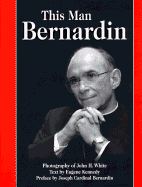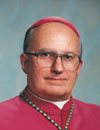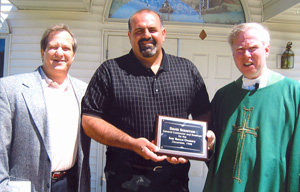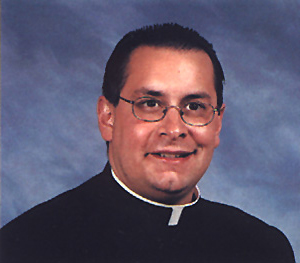 | Most
Rev. George Murry, who as vicar of Region VI, the southern suburbs of
Chicago, got permission to rebuild St. Rocco as an Oratory. To him be
enduring thanks and praise.
|
 | This Man Bernardin, a visual biography by John White
|
Responding to the request of his
vicar, Bishop Murry, Cardinal Bernardin had granted permission for the
building of San Rocco Oratory, on the grounds of the now-closed San
Rocco Church. Not long previously, in 1995, Cardinal Bernardin had
sent bulldozers to level the church, school, and rectory. Except
for the Mt. Carmel Club and the grotto, with the Stations of the Cross,
the entire complex had been demolished. Now, in 1996, the
Cardinal permitted a new church building to be constructed. Cardinal Bernardin died November 14, 1996.
 | Most
Rev. Raymond Goedert, Vicar General of the Archdiocese of Chicago. The
Vicar General is second in authority only to the bishop of the diocese.
Overall, especially in the absence of Cardinal Bernardin, the Vicar
General has the same kind of executive authority as the bishop. He can
neither legislate nor teach as the bishop does, but he does have
executive authority, to manage and govern.
|
In May, 1998, Bishop Murry was
transferred to the Virgin Islands, to be coadjutor bishop there. As
coadjutor, he would take over as head of the diocese, when the bishop
there retired. Now, as of July, 1998, the new vicar of this region
(Vicariate VI) was Bishop Joseph Perry, who had
been teaching canon law in Milwaukee. However, he grew up on
the South Side of Chicago; in a sense, he was returning home. The
first Mass at the newly constructed San Rocco Oratory was Christmas Day,
1998, presided over by Bishop Perry.
 | August
Anselmo, Dave Sebastian, and Father Gilligan. During 1999, August was
making phone calls, asking available priests to come to San Rocco and
say Mass on Sunday. No regular priest was assigned. During 1999, Mass
was often celebrated by Father Paul Longo, a Comboni Father, and Father
Andy Santos, newly ordained as of 1997.
Above, Dave Sebastian holds a plaque honoring him as general contractor
for the building of San Rocco Oratory in December, 1998.
|
|
Cardinal: St. Rocco Parish to remain closed
(from The New World, February 12, 1993, p. 8:)
Regarding
the status of the former St. Rocco Parish, Chicago Heights, closed in
August, 1990, the Archdiocese of Chicago has released the following
statement, dated at the Office of the Chancellor Feb. 12, 1993: The
Archdiocese of Chicago has repeated the process of consultation as
required by church law and, in light of the advice given by the council
of priests, Cardinal Bernardin decided that St. Rocco Parish in Chicago
Heights will remain closed.
St. Rocco Parish had been closed by the archdiocese in 1990, but after
an appeal by some parishioners, the Vatican's Supreme Tribunal of the
Apostolic Signatura issued a decision on Sept. 22, 1992, indicating
there had been a procedural defect in the process of the prior
consultation with the council of priests, known as the Presbyteral
Council. Due to this procedural error, the Vatican
decision ordered St. Rocco Parish restored to the status which it
enjoyed before it was closed. At the time of its closure in 1990,
St. Rocco was part of a planning process for the parishes in the Chicago
Heights area.
After reviewing his options under church law, Cardinal Bernardin
concluded that he would not contest the decision of the Vatican
Tribunal. In coming to this conclusion, however, he emphasized that he
considered the decision to be the result of a serious misunderstanding.
Since the Vatican decision addressed only the procedure and not the
substance of the decision to close the parish, Cardinal Bernardin
returned to the Presbyteral Council to consult with it according to
revised procedures and hear its advice anew concerning the status of the
parish. This
meeting, which took place Friday, Dec. 11, 1992, resulted in a unanimous
vote (40-0-0), advising the cardinal to close the parish.
The cardinal took this recommendation under advisement.
After meeting with representatives of the former St. Rocco Parish, the
cardinal decided to affirm the decision to close the parish.
St. Rocco Parish was established in 1905 as a national parish for
Italian immigrants. Changing demographicss in recent years
indicated that a special parish was no longer needed in Chicago Heights
for Italian immigrants.
For the larger Chicago Heights area, the 1990 census reported a 17
percent increase in the Hispanic population in the area durng the 1980s,
while the white, non-Hispanic population decreased by 20 percent during
the same period (1980-1990). In the immediate area around St.
Rocco church, the Hispanic population increased by 21
percent while the white, non-Hispanic populations decreased
by 20 percent. An
average of 661 parishioners participated at the five scheduled
weekend Masses at St. Rocco Parish during the last two years of
operation. Fewer than 100 of these attended the one scheduled
bilingual Mass in Italian and English.
Three parishes remain open in Chicago Heights: St. Agnes,
St. Kieran and St. Paul. One, St. Paul Parish, is less than
one-half mile from the former St. Rocco church.
The 1990 U.S. census shows a total of 11,454 residents in this
immediate area. The area of most parishes in the city are home to
10,000 to 15,000 persons, while in the suburbs, most parishes are set in
areas that have 15,000 to 20,000 residents. Consequently, to
maintain two parishes--St. Rocco and St. Paul--in the immediate area
would not provide an equitable distribution of available financial
resources and personnel.
In implementing the decision of the late Cardinal Bernardin, Bishop Goedert formulated statuta
("statutes") according to which the new San Rocco Oratory would be set
up and operated. Like a parish church, the oratory could have Mass
on Sundays and weekdays, as well as baptisms, marriages, funerals,
devotions, and other celebrations. However, the people themselves
were responsible for the facility, its upkeep, and for finding a priest
to help out. Financially, the people themselves were to assume the
entire cost of construction. In 1997 and 1998, the community
raised funds, did planning, and made arrangements for a new church
building. In 1998, work began; the new church was built just to
the north of the location of the old San Rocco church building.
Pews and other necessities were in part obtained from storage at the
closed St. Boniface church on the North Side of Chicago; here were
statues and other furnishings from churches that had been closed. The
overall cost of the new San Rocco Oratory, including about $50,000
donated labor and materials, was roughly $200,000. By the very end
of 1998, much of the work was completed. From the old San Rocco,
the new oratory had the original statue of St. Rocco, as well as the
baptismal font. Later, in 2004, the ceiling lights
from the old church would be installed in the new oratory. After
Bishop Perry arrived on the scene, Bishop Goedert met with
him, as well as August Anselmo and Mayor Angelo Ciambrone.
Bishop Goedert spelled out clearly what he wanted done, with regard to
the new oratory. During 1999, the San Rocco Oratory was in use,
regularly, with a variety of priests, subject to availability.
Deacon Ray Deabel, from St. James Hospital, helped out, as did several
other members of the clergy. Sometimes, it was difficult to
find a priest for Sunday Mass. However, congregational singing for
Sunday Mass was supported by both Vicki and Madeleine Mancini,
volunteers. In early 1999, while still no priest was assigned,
August Anselmo obtained both a tabernacle and a presidential chair for
San Rocco Oratory. Although he was saying Mass regularly at Infant
Jesus of Prague Church in Flossmoor, in late 1999, Father Michael
Gilligan began to help out at San Rocco Oratory. As long as there
was no schedule conflict, he was able to do this. When there was a
conflict, he got someone else to preside, such as Father J.C. Murray, a
retired Navy chaplain.
 |
 | Especially
in 1999, when San Rocco had no priest assigned, Father Andy Santos
helped out generously. At the time, he was an associate pastor at St.
Lawrence O'Toole, Matteson, Illinois. His grandfather, with the name
Santos, was Greek.
|
|